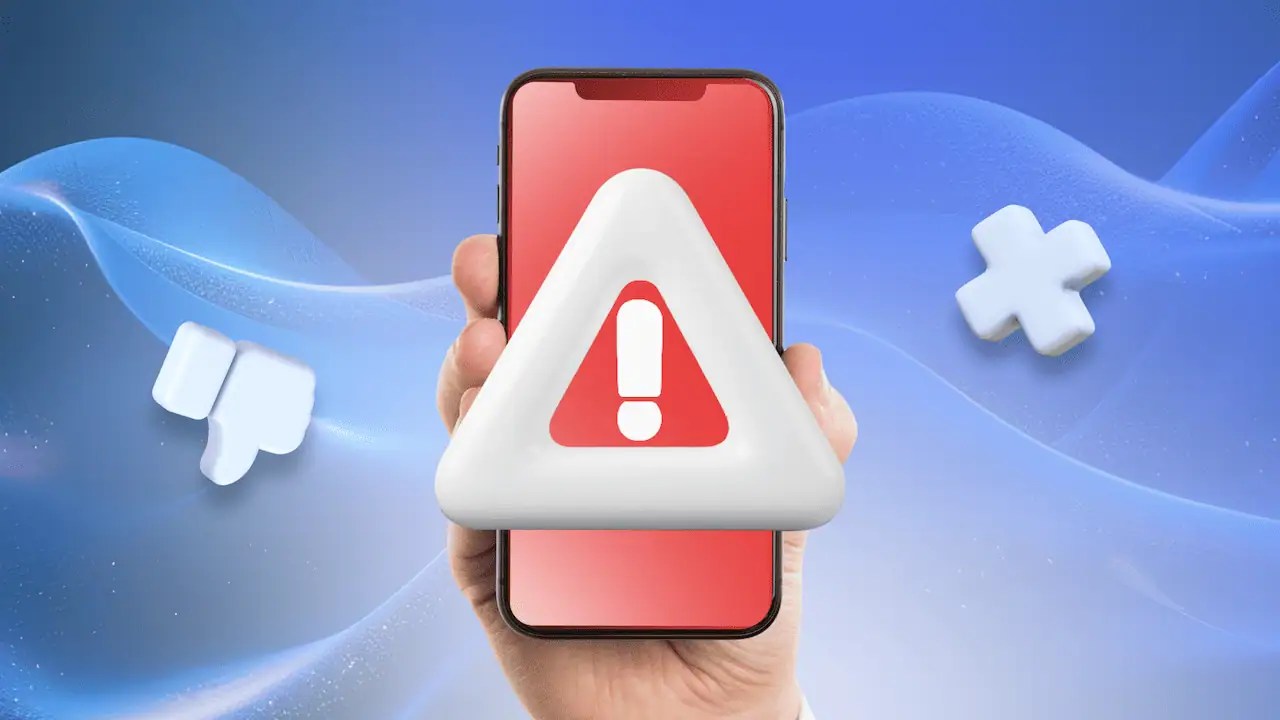When simple emails, calls, chats, and meetings can pivot your business, exceptional communication tools are a must.
So, what’s the ideal platform for business communications? The truth is, there is no one-size-fits-all solution, but there are a few that come close.
From AI add-ons to asynchronous capabilities and remote-friendly features, the sea of communication tools is vast and crowded. That’s why we’ve rounded up the best ones that meet the demands of today’s dynamic distributed work environments.
These tools are leading the way and empowering those who use them. But first, let’s see why business communication is so important.
Why Business Communications Matter
Business communication is the flow of information both within and outside an organization. Communication facilitates collaboration among teams, leaders, and external parties to achieve company objectives.
Effective business communication can build trust, maximize productivity, and increase employee retention within teams. Meanwhile, breakdowns in communication are often responsible for missed expectations. It goes both ways.
According to McKinsey, poor communication can significantly hinder the success of business projects. A survey revealed that 44% of executives linked team communication barriers to project delays and failures, and 18% blamed miscommunication for lost sales, sometimes amounting to hundreds of thousands of dollars. These insights highlight the critical role of effective communication in business success and the high costs associated with communication breakdowns.
Related: Business Communication Trends To Know in 2024
The Current State of Business Communication
To select the right tools, let’s start by examining how teams communicate. Based on a study by Project.co, team communication currently looks like this:
- 31% use email.
- 30% use team messaging tools such as Slack.
- 15% use project management tools.
- 7% communicate by phone.
- 7% communicate face to face.
Many companies permanently adopt remote work; however, this setting introduces additional communication obstacles, including wasted time, missed messages, burnout, missing files, bad customer experience, and customer attrition.
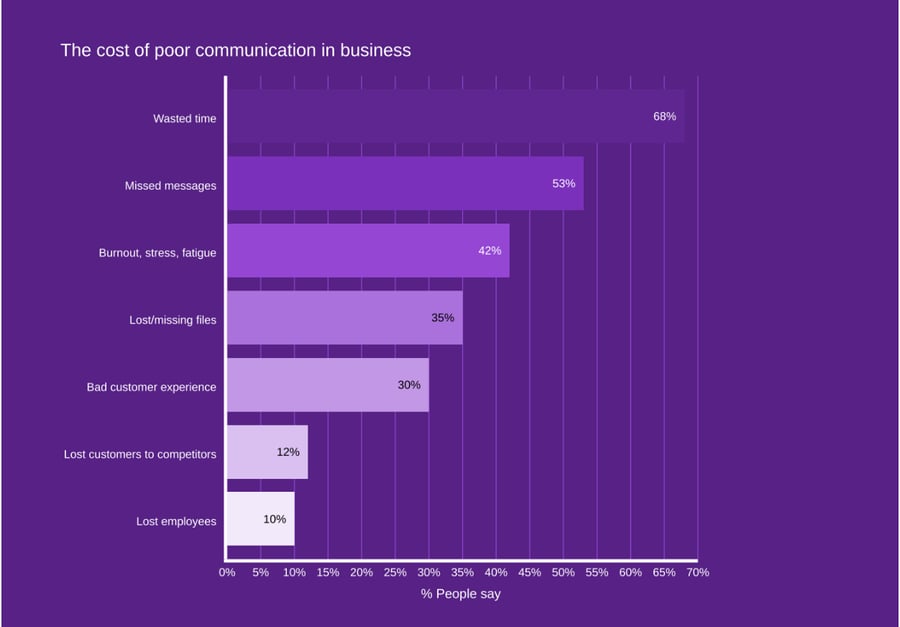
If you’re a business owner grappling with communication management challenges in a remote setting, you’re not alone. Over 70% of businesses have adopted new tools in the past year to help organize, communicate, and manage projects.
In 2024, businesses are moving toward adopting unified communication tools that reduce uncertainty, improve decision-making, and fully support the needs of remote teams. These tools integrate AI, asynchronous communication, and varied business channels, offering a reliable, effective, and engaging way to enhance workforce communications.
Related: What Are the Best Business Communication Channels to Use?
Best-Rated Business Communication Tools
1) Nextiva
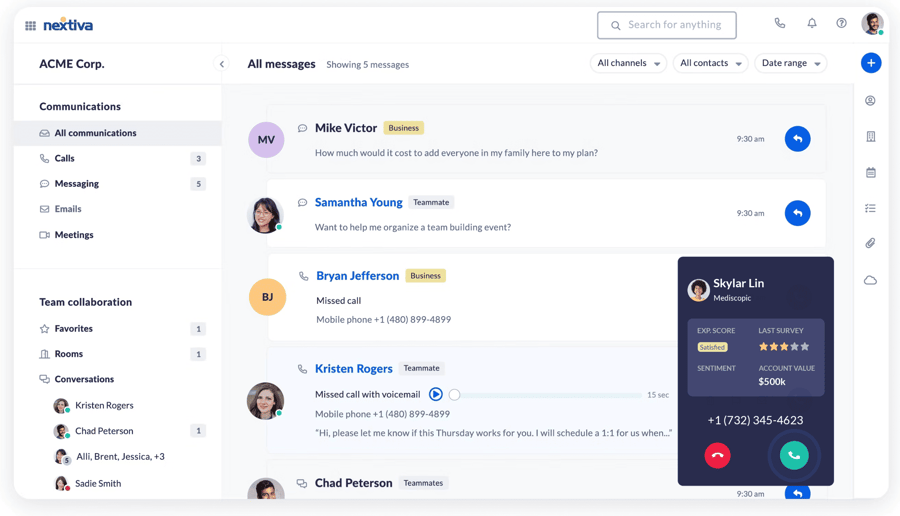
Nextiva is a Gartner award winner that stands out as a top business communication platform. Combining voice calling, team messaging, video conferencing, call center capabilities, and customer management tools efficiently into one easy-to-use platform, Nextiva helps business owners take control of their communication channels.
Businesses that partner with Nextiva can easily deliver personalized, world-class customer service and communicate seamlessly with their teams, no matter where they are.
How Nextiva improves business communication
By streamlining multiple channels into a single platform, Nextiva helps businesses save time, deliver personalized customer support, make faster decisions, and avoid costly miscommunication. Never miss a customer or employee message with Nextiva’s unified communication system.
Notable features
- All-in-one business communication (VoIP phone, team messaging, video chat, and more)
- Customer relationship management
- Desktop and mobile apps (iOS and Android)
- AI workflow automation and advanced analytics
- Social media and reputation management tools
- Contact center solutions and advanced call routing
Customer rating: 4.5 out of 5 (2,908 G2 reviews)
2) Slack
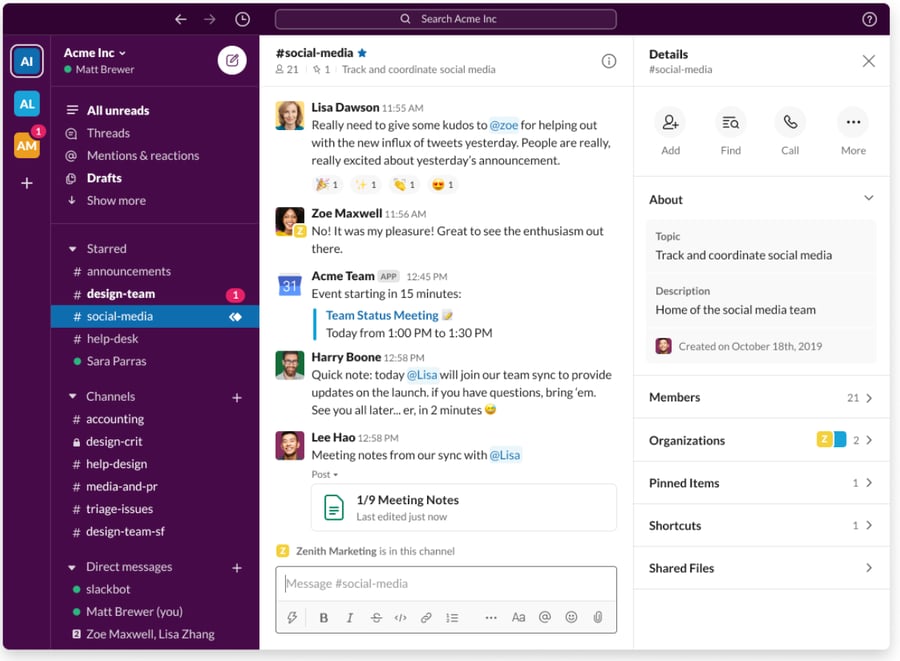
The powerhouse of team messaging apps, Slack often replaces email as the main communication channel for business teams. It also streamlines employee communication and file sharing, making it easy to distribute information.
Slack’s user-friendly interface makes it easy to manage multiple conversations and stay on top of communication channels, helping teams stay organized and on the same page.
How Slack improves business communication
Slack takes the pain out of business communication by centralizing all business team messaging, files, and tools in one easy-to-use messaging platform. Slack replaces email for many businesses, offering a tool that provides better organization, speed, and security.
Instead of long and cluttered email chains, communication is organized into channels that are easy to create, search, and join. Each channel facilitates work group chats, employee engagement, and team collaboration.
Notable features
- Business instant messaging with file-sharing capabilities
- Searchable conversation channels
- Straightforward integration with popular productivity apps and tools
- Easy invitations for external team members or guests
Customer rating: 4.5 out of 5 (32,191 G2 reviews)
3) Notion
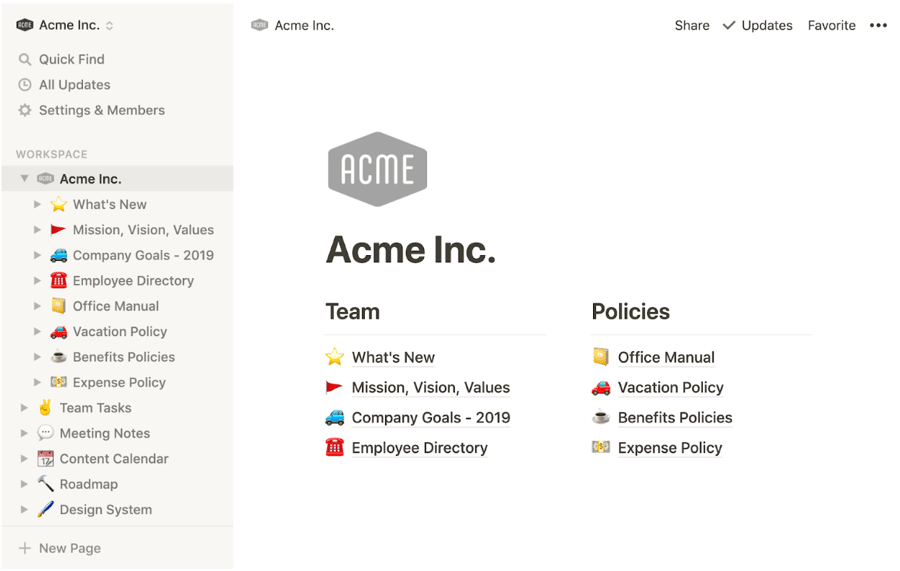
Notion is an all-in-one workspace that unites note-taking, project management, databases, image galleries, and calendars in one simple and intuitive platform.
Start from scratch and customize the platform to your specific business needs, or utilize Notion’s library of professional templates for a solid head start. This adaptability makes Notion a popular choice among small business owners who want a cost-effective yet tailor-made tool with a wide range of applications.
How Notion improves business communication
Notion simplifies business communication by helping teams stay organized in one unified space. Its customizable tools for project tracking and task delegation provide clarity and accountability for remote, hybrid, or in-office teams.
Notable features
- Comprehensive note-taking and documentation app
- Fully customizable task management and databases
- Project management with calendar and timeline views
- Sharing and collaboration tools
Customer rating: 4.7 out of 5 (5,031 G2 reviews)
4) Asana
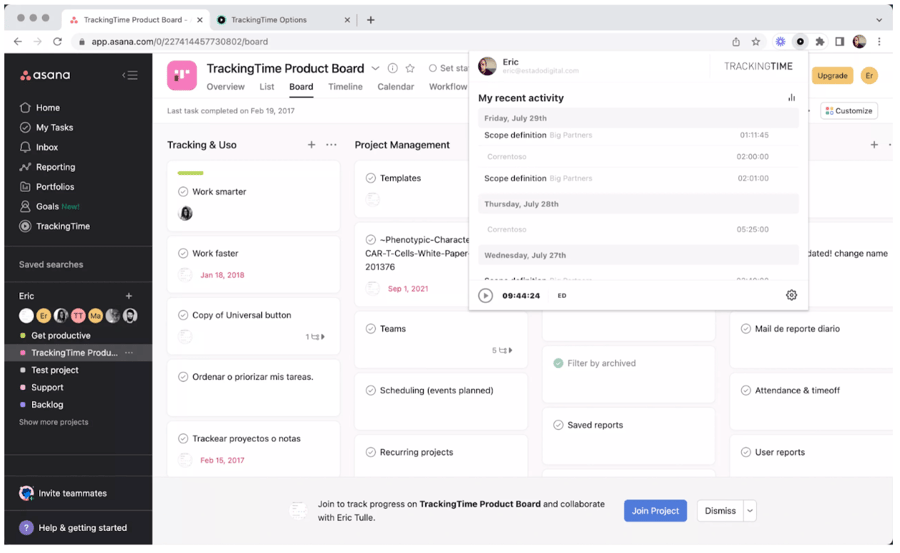
As a leader in the project management space, Asana is known for its sleek user interface, comprehensive set of workflow and automation capabilities, and resource management features.
With Asana, teams can easily manage all their projects, goals, and responsibilities across departments and deliver high-quality work. With predictive AI features coming soon, managing projects with Asana is about to get even better.
How Asana improves business communication
Asana’s project management capabilities provide teams, both small and large, with complete views of tasks, project timelines, and updates. Its streamlined interface ensures that everyone is aligned on tasks and responsibilities, reducing the need for excess messaging and minimizing miscommunications.
Notable features
- Comprehensive project management tool
- Customizable project views (e.g., Kanban boards) and permissions
- Popular app integrations (e.g., Miro whiteboard integration)
- Project templates and dashboards
Customer rating: 4.3 out of 5 (9,550 G2 reviews)
5) Zoho One
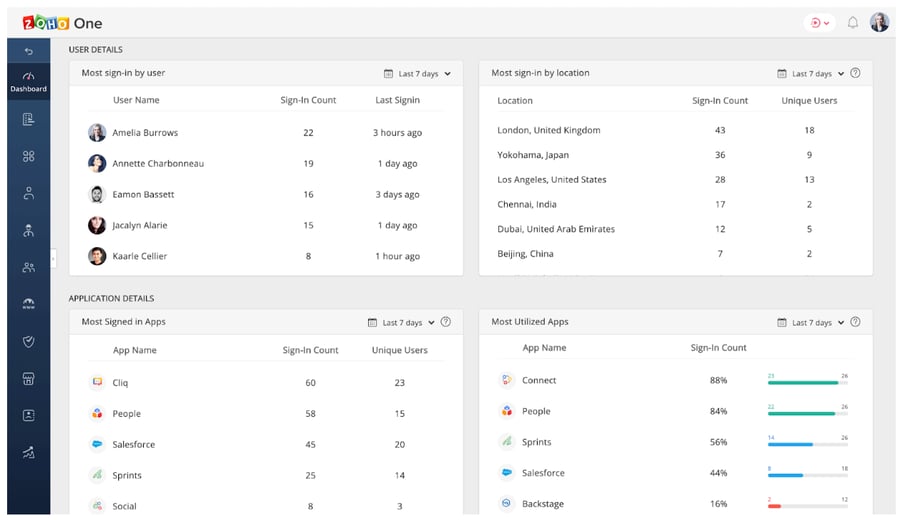
Often referred to as the business operating system, Zoho One integrates applications for sales, marketing, support, accounting, operations, and human resources into one platform.
With over 55 applications to choose from, business owners can fully customize the platform to their specific needs. Zoho aims to eliminate barriers between departments and increase operational efficiency.
How Zoho One improves business communication
Zoho One combines communication, project management, CRM, finance, and integrated human resources tools into one platform, enabling better coordination and information flow across business departments.
Notable features
- All-in-one platform providing more than 55 CRM, sales, and marketing tools
- Collaboration features and productivity functionality
- Finance and HR management tools
- Customizable and scalable tool
Customer rating: 4.4 out of 5 (19,129 G2 reviews)
6) Loom

Loom enables teams to easily record and share interactive videos with teammates and customers. This unique tool helps teams solve issues, provide feedback, and supercharge productivity.
The asynchronous nature of video sharing and the human touch improve focus, clarity, and connection within distributed teams.
How Loom improves business communication
Loom provides easy-to-use screen and video recording tools, providing a personal and engaging way to share information and feedback, especially for remote teams.
Loom can be used to record webinars, reply to messages with detailed video feedback, and distribute recurring information company-wide.
Notable features
- Easy-to-use dual-screen video recording and sharing
- Transcription and closed captioning capabilities
- Interactive viewer reactions and insights
- Straightforward integration with popular productivity tools
Customer rating: 4.7 out of 5 (1,827 G2 Reviews)
Selecting the Best Communication Tool for Your Business
✔️ Is cloud-based and has a fast setup
A cloud-based tool enables easy access from anywhere, making it ideal for distributed and global companies to communicate and share files through cloud storage.
Choosing a tool that requires minimal configuration and integrates into your existing infrastructure prevents downtime and allows your team to get started quickly.
✔️ Offers a blend of asynchronous and real-time communication functions
Your communication platform of choice should feature a mix of asynchronous (e.g., email and team messaging) and real-time communication features (e.g., video conferencing tools and instant messaging apps). This blend caters to different work styles and project needs while ensuring flexibility in how your team communicates, especially in hybrid work models.
Asynchronous communication is meant to minimize distractions and notifications, allowing the recipient to work uninterrupted.
With virtual meetings falling in popularity, teams crave more asynchronous work formats. A 2023 study found that 42% of knowledge workers wanted more of this working style, while only 14% craved less of it. Other significant advantages of asynchronous work include its ability to minimize burnout, boost team confidence, and enhance productivity.
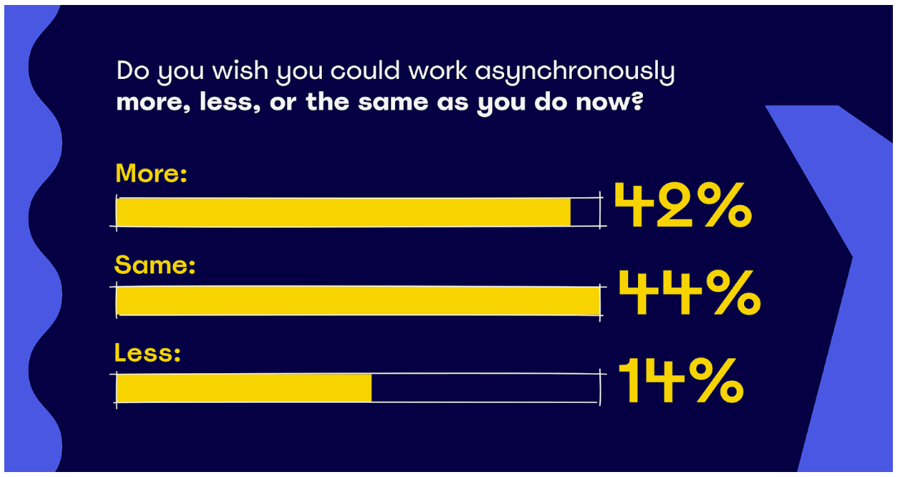
What’s more, companies that excel at asynchronous work can use related data to boost their AI-driven efficiencies.
✔️ Solves practical business needs
Consider the practical nature of each tool and focus on its essential features as they relate to your team’s specific needs rather than being distracted by additional bells and whistles. Sure, new AI functionality may sound cutting-edge and cool, but is it worth the switch if the features you use most lack the functionality you need?
Whether you’re managing projects, brainstorming ideas, or conducting online meetings, each tool should enhance these tasks, not complicate them.
✔️ Integrates with existing apps
If you’re an established business, you likely already have a few team communication tools that you don’t want to part with. Ensure that any new platform offers easy integrations with the apps and tools your business already uses.
Just take it from the peer-to-peer software review site G2: integrations significantly reduce the time spent on juggling separate tools and increase productivity. Nextiva easily integrates with popular tools such as Zoho, Salesforce, HubSpot, Zendesk, Microsoft Outlook, Google Workspace, Microsoft Teams, and Oracle Sales Cloud.
✔️ Offers mobile and desktop apps
These days, a lot of teams can work from anywhere. Choosing tools that are as mobile as your team will power productivity in a way that feels right for team members. Mobile and desktop apps ensure they can stay connected and productive from their homes, in the coffee shop, or at a work site. Bridging the gaps between home, office, and on-the-go workspaces is as important as ever.
✔️ Has flexible pricing plans
The right tools offer pricing options that can scale with your business. Look for flexible pricing plans that provide basic features in the lower tiers while providing more advanced functionality for large teams. As your business grows, avoid the hassle of switching to another new tool. Select one that can adapt and meet your evolving needs from the start.
Related: Top 20 Business Communication Apps for Your Team
Improve Productivity & Work Faster With Nextiva
In the past year, customer and market demands have increased, and what we expect from a communications platform is far beyond what we envisioned even a decade ago.
Communication tools are the linchpin to supercharging teamwork and scaling business productivity.
The right tools can provide clarity, enhance decision-making, and fully support the new hybrid model of remote work. Looking ahead, AI is set to play an even greater role in revolutionizing external and internal communications, offering smarter, more intuitive, and increasingly automated ways to connect and collaborate.
Each of the tools discussed — Nextiva, Slack, Notion, Asana, Zoho One, and Loom — brings unique features to the table. These platforms are at the forefront of enhancing business communications and will only become more efficient, predictive, and personalized as AI advances.
As you explore the best possibilities for your business communication strategy, it’s important to choose the right tools. Nextiva stands out as a unified, cloud-based platform that addresses the communication needs of small businesses and adapts as your team grows. Discover how Nextiva can transform your business communication.
ONE communications tool for your team.
Streamline several communication channels into ONE with Nextiva.
Communication Tools FAQs
Startups thrive with external and internal communication tools that are affordable, easy to use, and scalable. Opting for tools that combine several communication channels, such as phone calls, video conferencing, team messaging, and social media management, into one platform complements the dynamic nature of fast-moving startups. Tools such as Slack, Zoom, Nextiva, and Asana help teams succeed in remote, hybrid, or in-office work environments. When choosing a tool, consider your startup’s industry, team size, and communication needs.
Enterprises require robust communication tools that maintain high security and privacy standards. These tools should also integrate easily into their existing IT infrastructure. Popular choices for enterprises include Microsoft Teams, Cisco Webex, and Nextiva.
Businesses should adopt tools that merge various channels into one simplified system to streamline internal and external workplace communications. Cloud-based communications platforms such as Nextiva offer a secure all-in-one solution that integrates key channels such as phone, video calls, team messaging, call center capabilities, and social media management. For remote teams, efficient communication begins with setting clear policies, sharing best practices, embracing asynchronous models, and choosing all-in-one tools that enhance the team’s effectiveness.






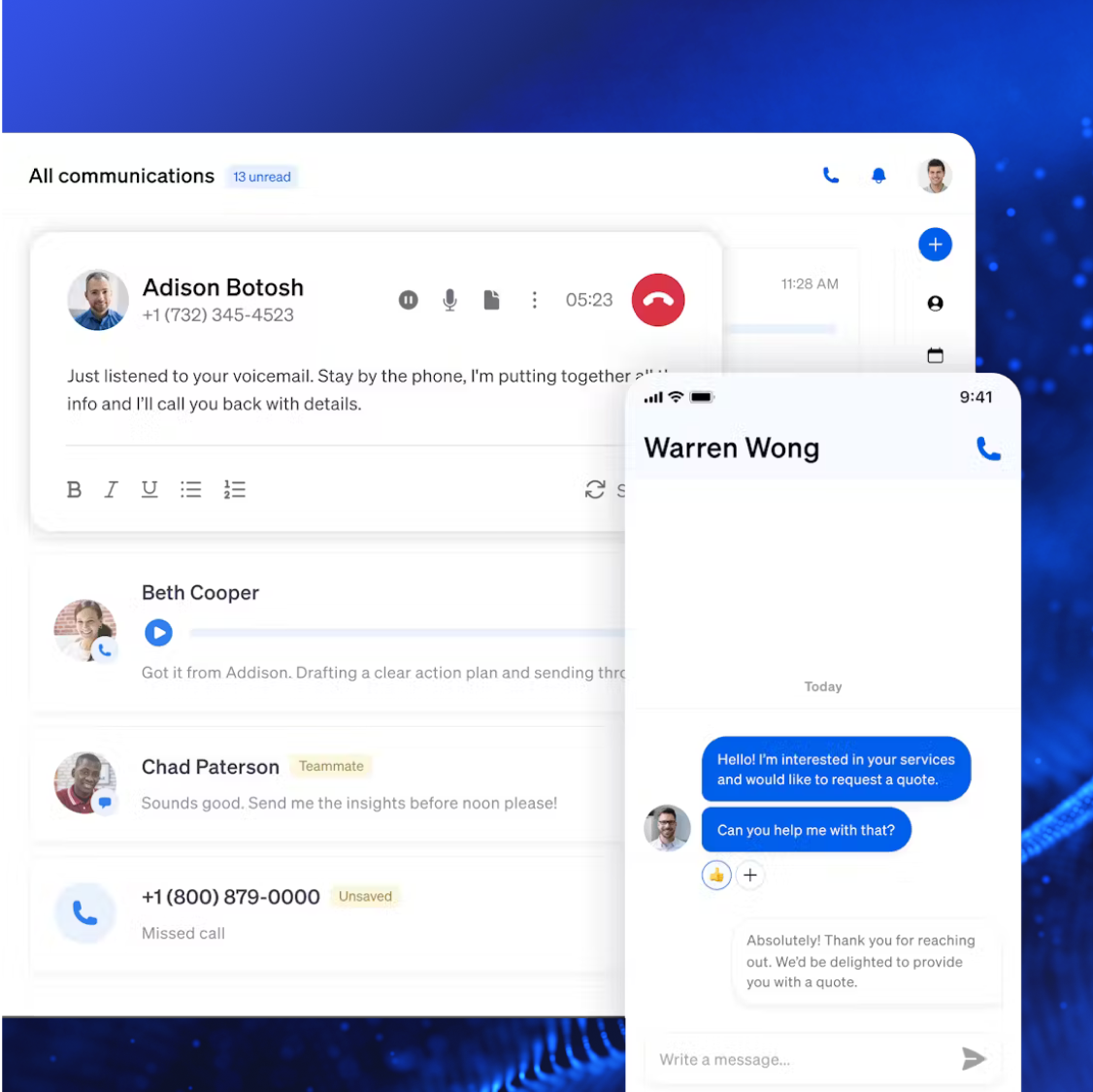








 Business Communication
Business Communication 







